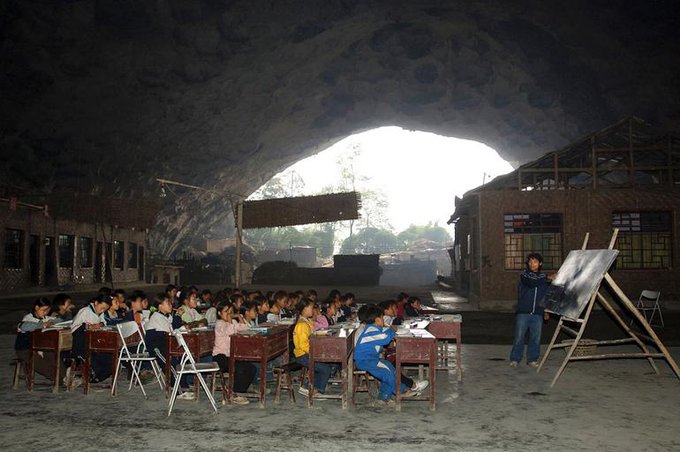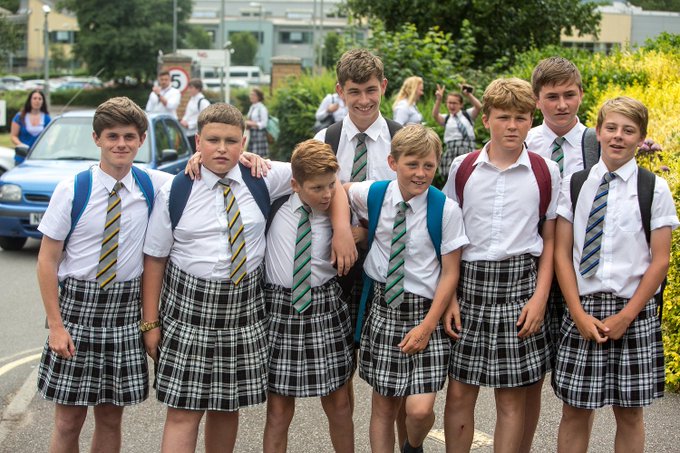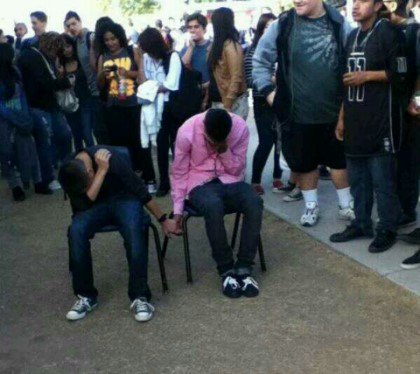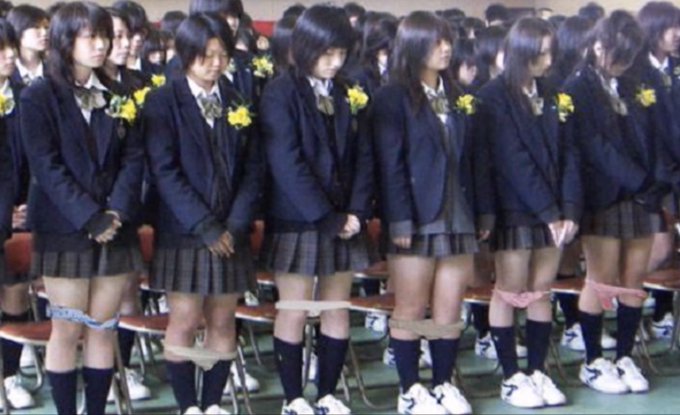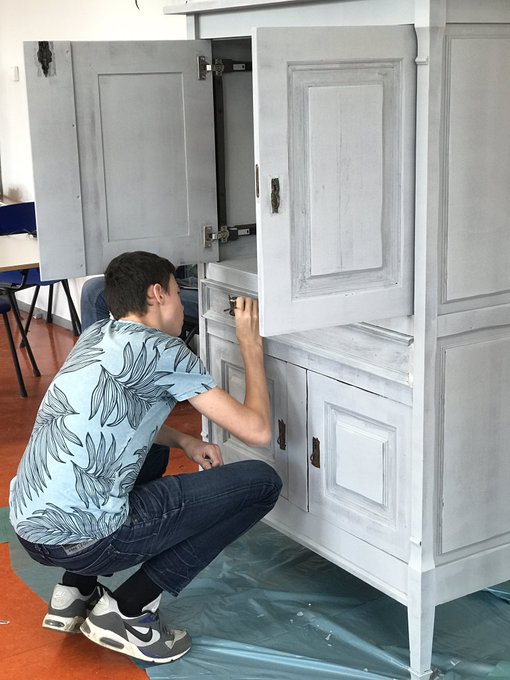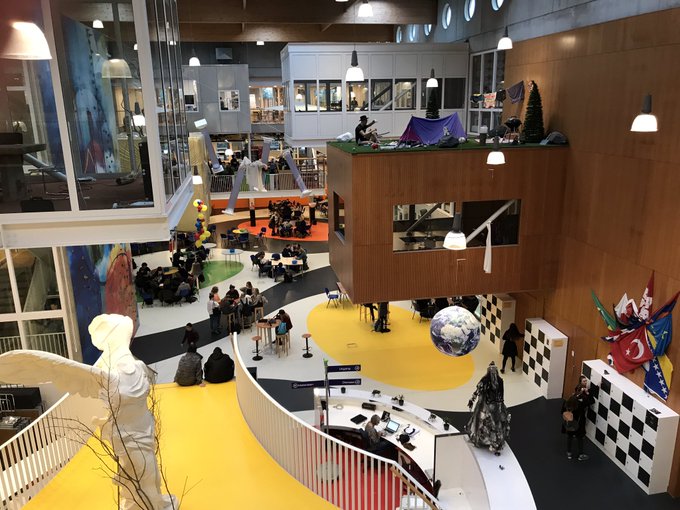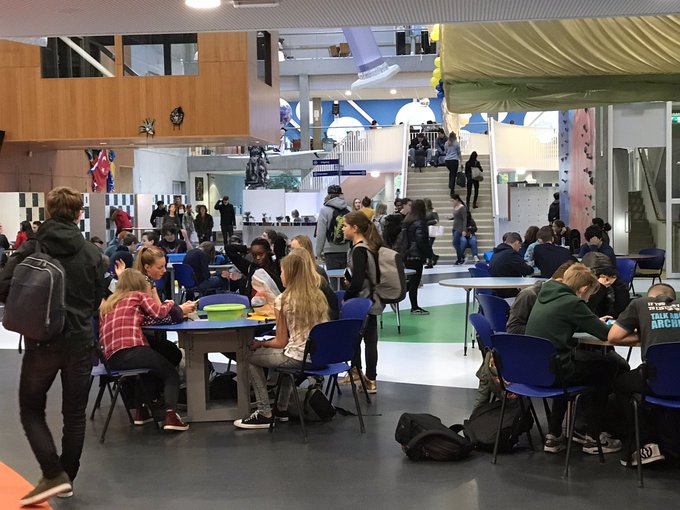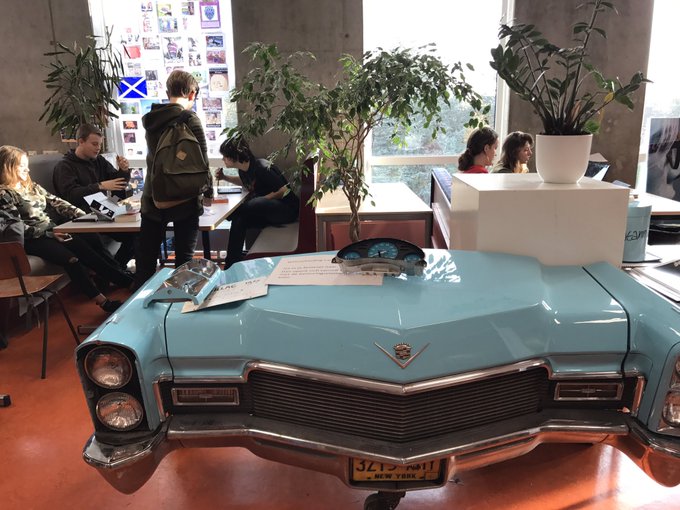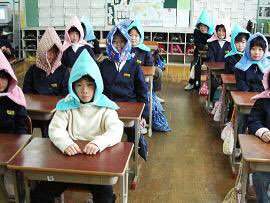For most students, school consists of cramped classrooms cluttered with desks, piles of textbooks, all-too-short lunch breaks, and an endless mountain of homework. But not all schools are the same! Around the world, class can take place anywhere from train platforms to palaces! Reprimands vary from writing lines to corporal punishment. And school lunches range from the good, to the bad, to the real ugly. Let's compare some of the best, worst, and weirdest schools around the world!
Campuses
If you’re anything like me, you probably think all schools look the same. The seemingly universal concrete courtyards, blocky buildings, and main double doors of any modern campuses are uniform enough to make even the most enthusiastic students feel depressed! But over in Jaipur, India, students of the Jayshree Periwal International School study in a literal palace, complete with a stunning set of spires and turrets!
Jaishree periwal school campus video drone shots mini 3 pro #drone #schools #jaipur #cinematic by NOOB CODM With its white walls and blue rooves, it looks more like a Disney castle than a campus! Though it’s not just a fantasy on the outside. This boarding school for the international elite boasts meticulously maintained tennis courts, a private pool, a shooting range, stables, and a castle themed theatre! Even their art rooms look like something out of a Disney film. But this dream-like campus isn’t cheap. To stay for the full boarding experience here, it can cost up to 778,000 rupees per term, that’s over $10,000! That might sound expensive, but it pales in comparison to the world renowned
Le Rosey school in Geneva, Switzerland.
Le Rosey - Intro - GB by Le Rosey
Perched close to the breath-taking shores of Lake Geneva, this is another boarding school accessible only to the uber elite. The main campus is nestled in a luscious parkland location, with traditional buildings lining pathways that lead to the campus’ crown jewel, the Carnal Concert Hall.
This 900-seat capacity steel dome is completely enclosed by giant glass windows and decked out entirely in expensive wooden finishes. As picture perfect as this school looks, it isn’t Le Rosey’s only setting. In the winter, students are moved to a second campus made up of a charming village of chalets in the alpine resort town of Gstaad. Not only do these kids have a second campus, it’s also a world-class ski resort!
So, how much would your parents need to fork out to send you here? Well, fees here vary from 130,000 to 150,000 Swiss francs. At the top end, that’s a wallet-busting $157,000 for just one year!
So, after looking at campuses built from mega amounts of money, what do schools on the other end of the spectrum look like? For that, we need to head over to Ziyun County, China, to the rural
Dongzhong Primary School. There are no doors, windows, or even walls in this school, as class takes place in an aircraft-hangar-sized cave in the hillside! Because access to education in this region is scarce, locals decided to turn the natural cave into a free place of learning for the children of some of China’s poorest residents. It was established way back in 1984, and at its peak the cave kept the rain off 8 teachers and 186 students. But sadly, it was shut down in 2011. Chinese authorities discovered the schools existence and ordered it to close, claiming it painted the country in a bad light. However, shutting down an essential school made them look even worse!While the kids in the cave were at least kept dry, over in Bangladesh, heavy monsoon season can flood up to 70% of the country. This means traditional brick and mortar classrooms often end up underwater, though even that doesn’t stop students turning up to class on time! Even when the water is at chest height, some classes apparently continue as normal! To combat this issue, the
Shidhulai Swanirvar Sangstha organization ingeniously designed a series of floating schools.
During Floods, Floating Schools Bring the Classroom to Students by Great Big Story These brilliant boat schools aren’t just dry spaces for desks and chalkboards though! Using solar panels on their rooves, electricity for laptops can be supplied on board. Not only that, but different boats serve different purposes, like an all-essential playground, so kids can have fun on a swing without fear of drowning if they fall off!These may not be the most conventional school buildings, but they’re better than what some kids over in Odisha, India have. With a shocking 134 million people living in poverty, many families in India simply can’t afford the luxury of sending their children to school. Instead, they’re forced to beg around crowded places like train stations in order to survive. Seeing this heart-breaking scene, several volunteers began setting up
free schools on the edges of train platforms to provide the children that gather there with a basic education. More than 12 of these platform schools exist up and down the region, with about 700 students all taught for free.
It’s a far cry from paying hundreds of thousands of dollars to learn in a fancy palace or a Swiss chalet! But we can all agree that any education is worth more than the building it’s taught in!
Food
For many kids, lunchtime is the best part of the school day. But if you’re not bringing your own lunch from home, this midday meal can look very different depending on where you are in the world.
Let’s start off in France, a land famous for its good food, even in its schools! Municipal governments are responsible for the
standard four course meal that most children receive. This usually consists of a vegetable starter, a warm main dish with more vegetables, a dessert, and even a complimentary cheese course.
France's Gourmet School Lunches by CBS It may look tasty, but it adheres to the strict guidelines of the government’s national nutritional requirements. These state that fried foods must be limited to four meals per month, and that ketchup can only be served once a week due to its high-salt, high-sugar content. And when such meals are served, they’re balanced out by nutrient rich foods such as mussels and even entire baked artichokes! Altogether, a typical meal can cost up to €8, that’s almost $10! However, students in low-income areas can receive financial assistance, ensuring no kid goes hungry. Over in Russia though, it couldn’t be more different. While the government started providing younger children with free hot meals in 2020, older students are left to rely on the finances of regional authorities. Wealthier regions receive not only lunch, but breakfast as well.
A typical breakfast could consist of tea with toast, porridge and even a cheeky sausage. And lunch is a more colorful affair. Typically, some sort of fish or meat will be served with a borscht – which is a kind of beetroot soup - a sugary juice, a starchy carbohydrate like potatoes, and bread. Sounds simple and nutritious – but only if you can afford it.
Everything You Need to Know About the School Lunch in the USSR by USHANKA SHOW Back in 2019, when the government didn’t offer any free school meals at all, poorer families struggled to provide the 50 roubles, which was just 75 cents, for even a basic lunch. It got so bad that some children were reportedly fainting in classes from hunger!But not too far away in South Korea, hunger definitely isn’t on the menu. Many older students attend private academies or night classes in the evenings, meaning they might be in school from 8 am to 11pm every day! So, they often get lunch and dinner provided by the school cafeteria. Lunch is usually a Korean staple of rice, healthy soups, protein rich meat or fish, noodles, and fruit. Dinner is a similar affair, with occasional fried treats like chicken nuggets, tempura, and grilled egg sandwiches.

If my school had provided dinners that looked that good, even I could have been convinced to study late into the night! But how much does this cost? Well, in the capital region of Seoul, it doesn’t cost anything at all. By investing a bank-bursting $615 million into the education section per year, Seoul planned to make all its public and private school meals free in 2021!
While all the meals we’ve learned about so far look pretty tasty in their own way, what some schools in the USA bring to the table will make you lose your appetite. The country’s National School Lunch program helps subsidize and fund meals for more than 31 million kids, providing about $1.30 per child. However, there’s still a heavy reliance on cheap, calorie dense, processed foods to keep costs down. And while this dependence varies from state to state, the menu of these "nutritionally balanced meals" doesn’t. Pizza and corn are a pretty common combination found in cafeterias from coast to coast. While some look like they could be tasty, they don’t always look good. The pizza from these schools looks like it was stored under the freezer instead of in it!

Cheap chili dogs and fries are another classic combination found in plenty of schools. Though the only healthy hint of green on these trays comes from some lone curl of lettuce, or wafer-thin pickles on the side. But if you’re not hungry for processed food on top of more processed food, then I’d stay away from the Nachos. If they’re not a gooey mash of grey and yellow, they’re swimming in enough cheese to block your arteries!
And speaking of cheese, did anyone order the mac and cheese? Maybe a more appropriate name would be “Penne Pasta Frisbeed with Cheese Singles.”
But not every American school makes such malevolent-looking mystery meals. Over in Georgia’s Savannah-Chatham County Public Schools, they serve up these tasty looking trays with the help of a local nutritional organization!
Alongside bringing actual chefs into the schools, students can chow down on meals made from locally grown ingredients. On a more normal day though, there’s still plenty of healthy green options to choose from! Starting at just $3 per meal, as well as providing free breakfasts for all students, these menus are both healthy and affordable! I’d give that an A+.As bad school lunches go though, none can compare to what the Democratic Republic of the Congo’s serving up in the American School of Kinshasa. Those aren’t over-baked fries, they’re caterpillars! Gross as they look, bugs like this provide a cheap common source of protein across Africa, meaning there’s probably more nutrients in this than most of the USA trays!
Uniforms
In the walls of a school, uniforms can make all students look the same, though, ironically, they’re not uniform around the world! In England, for example, a basic uniform sees all students dressed in specific colors. Most girls can opt to wear trousers when it’s cold and skirts or dresses when it’s hot, but not all schools allow boys to wear shorts in summer.
This led the boys of the Isca Academy in Devon to get creative during a particularly sweaty heatwave. While there was a rule against shorts, there was no rule against skirts, so they all turned up to the school gates wearing these very fetching
gingham garments in protest! And they’re not the only ones. Across the pond in Quebec, Canada, male students started turning up to school in all styles of skirts back in 2020. Not because they couldn’t wear shorts, but because female students weren’t allowed to wear skirts above a certain length, while the boys could hike up their shorts as much as they wanted! In solidarity, students across the province
joined the movement against the double standard.
Since then, more and more schools around the world have started adopting gender neutral uniforms, with many boys and girls being given the option to wear skirts or trousers regardless of their gender!
Though not every school in England has such a modern approach to uniforms. Since it was established back in 1560, students at Christ’s Hospital School have sported the exact same uniform for more than 4 centuries! With a billowing, cape-like frock coat, shiny silver buttons, a brown leather belt, and long yellow socks, these kids look like they’re about to head off to Hogwarts, not homeroom!
Though the Christ’s Hospital uniform isn’t the only one that’s been around for a long time. During the soviet era, schools in the USSR required boys to wear dark suits with white shirts, and for girls to wear white aprons, knee length socks, and bows in their hair. These adorable little outfits were abolished in 1994 after the fall of the soviet regime, but they still play a role in some schools today.
On the last day of school, older students will dress up in the old uniforms to celebrate the end of their education. They’re the spitting image of the uniforms from almost 30 years ago, except for high heels. I’m not sure kids back then were able to sneak into class with all those extra inches!
As adorable as the soviet union’s old uniforms were, there’s some cute competition coming from Japan. In high school, the boys sport slick, black, almost military style uniforms, while the girl’s look more like little sailor outfits!
These European naval style uniforms are called Seifuku, and the reason they’re military inspired is to help instill a sense of discipline into the students wearing them. But instead of smart dress shoes, on their feet they wear a pair of bright white slippers.
These are uwabaki, a type of soft indoor shoe that keep the floors in the school building clean. In Japanese culture, it’s quite normal to remove your shoes at the door of homes and even big buildings to keep cleaning maintenance down to a minimum. At school, students change into their uwabaki at a locker lined entrance called a Genkan, and their grade might even be indicated by the color painted on the toe.
Rules and Punishments
Sitting in detention and writing lines for hours on end is a pretty standard school punishment for most bad behavior. But the lesson doesn’t always get through to the student. So, while some teachers take it upon themselves to get creative with their reprimands, others just go way too far.
Over at Woodland High school in Mesa, Arizona, two students were caught scuffling back in 2012. They should have been suspended on the spot, but the principle offered them a lesser, albeit more embarrassing option; they had to
hold hands for 15 minutes in public!
As they locked palms, the two were relentlessly mocked and photographed by their classmates. To make it worse, the images then hit the web, making their embarrassment an online spectacle! While some saw it as a controversial countermove, the lesson of "no fighting in school" really hit home.But across the states in Detroit, punishments aren’t always that funny. Back in 2011, a 13-year-old student caught running through the corridors at the David Ellis Academy was given a choice: stay behind after school or do 60 push ups. I can do about 5 push ups at best, so I’d have just taken the after-school option.

But this kid was determined to keep his personal time, so he completed the enforced exercise. Suddenly, he began suffering from a condition called Rhabdomyolysis. Within hours, his arms swelled up from overexertion, and he was rushed to hospital. This punishment may seem extreme, but shockingly, 19 US states allow corporal punishment in schools! Even preschoolers are subject to punishments like a good old-fashioned paddling. And I thought that was just a Simpson’s sketch!
Across the sea in South Korea, corporal punishment in schools is a prohibited practice, though it’s far from a distant memory. Banned since 2012, students were once punished by being made to do grueling upside-down push-ups, or sit in stress positions with their arms raised. This could have been for something as minor as forgetting homework or being late for class!
Embed for https://x.com/_InstructorBot_/status/373889124563816449 could not be displayed
Although some teachers have had a hard time letting go of the past. In 2016, a teacher violated the new child protection laws by hitting a student with a club over 500 times! As bad as these punishments sound, they’re nothing compared to the rules of some 14 schools in Japan’s Saga prefecture. Up until 2021, these public-school students had to adhere to a very strict dress policy, right down to the color of their underwear, which had to be white! And how did teachers check this? By creepily forcing students to show their underwear, and even remove them if they were the wrong color! That’s a punishment in and of itself! And you thought writing lines was bad.
Hours
Assuming they aren’t staying behind in detention, the amount of time children spend behind their desks also depends on where they are in the world. In America, for example, the typical high-school days starts at 8 am and, after a 30 to 40 minute lunch break, finishes between 3 and 3.30 pm. So about 7 hours in total, which seems pretty long when you break it down like that!
Over in China though, 7 hours is just the start of the day. Most schools start at 7.30 am, and run until the early evenings, around 5 pm. This does include a 2-hour lunch break, but the day doesn’t stop there. Many schools host evening self-study classes, keeping kids at their desks until as late as 9pm! And to top it off, they also have to do their homework before heading to bed! This super-long school day is driven by the country’s fierce competitiveness to get into good universities, so kids are taught to study properly from a very young age. So much so that in some primary schools, desks even come with bars like this so kids don’t get too close to the paper and strain their eyes. Sort of looks like the world’s most boring rollercoaster ride!
Competing with China for the worlds longest school day are their neighbors in South Korea. with school starting as early as 8 and finishing at 4, many students then clean their classrooms before attending private schools or tutoring sessions which can run as late as midnight! Even with a 50-minute lunch break, and a brief rest for dinner, students add an extra 4 or 5 hours onto their already 8-hour school day!
Curriculum
While maths, science and literacy may be taught the world over, not all schools boast the same old boring lesson plans. Over in the previously mentioned, uber elite Le Rosey boarding school, students have up to 9 intensive classes a day. And not just in one language, but two! The school focuses heavily on bilingualism, with subjects from geography and history through to art conducted in both English and French. Though the art classes aren’t just a crayons and paper affair!
Le Rosey kids get to work with textiles like silk and porcelain and can create things using 3D printers and scale model making techniques! While creative subjects in La Rosey are clearly a very well-funded part of the curriculum, over in Agora School in the Netherlands, they form the core of the curriculum. Or they would if the
school had a set curriculum! This unconventional institution doesn’t adhere to typical class and subject structure, and instead encourages children to explore any topics they find interesting! From Mongolian horses to Harry Potter patronuses, students develop projects that teachers incorporate the key mechanics of learning into. For example, each child gets a desk they can customize any way they like, built from intricate woodcarvings to cut up cars! But they have to do it all themselves, so they have to learn key mathematical components to make it all work. That’s creative and constructive! While the Netherlands is exploring new ways of teaching old subjects, Japan is having to teach some students the basics. Across the country, elite all male boys high schools have started teaching classes in how to raise children and be good husbands. Japanese men have, for the vast portion of history, been the family breadwinners. But with women becoming more prominent in the workforce, the country’s stay-at-home parent stereotype is changing. So, these lessons in childcare, interaction, and communication teach the boys how to be good fathers! Talk about becoming a modern man.
Although, in Russia, learning house husbandry isn’t as important as learning strategy. In 2019,
Russia introduced a compulsory subject for first graders that shocked the rest of the world: chess!
In line with new government rules, all Russian first graders were required to study the black and white strategy game for at least 33 hours a week! Even though it’s not everyone’s idea of a fun game, children who play chess perform almost 40% better academically than those who don’t. Checkmate!
Drills
Just about every school does routine fire and evacuation drills, but those aren’t the only emergencies some schools have to prepare for. Over in Japan, approximately 160 magnitude 5 or higher earthquakes rock the country every year. Few reach magnitude 6 or higher, but when they do, they shake the nation with devastating consequences. Big buildings can collapse in a matter of moments, so kids in school are routinely trained in what to do should that happen!
From an early age, children are taught to get under the desk headfirst to protect themselves from anything falling, and to stay there until the earthquake is over. Then, once the worst is over, they don little protective, padded hats called bosai zukin, which keep their heads and necks safe from any falling debris, and proceed outside. But falling debris isn’t the only thing schools in highly seismic areas have to worry about! In 2013, one of the biggest tsunamis in history made landfall in the Philippines. But at the time, almost no-one knew what was happening, and without any drills or warning systems in place, around 6,300 people and students lost their lives.
Now though, coastal schools engage in
fully coordinated Tsunami drills to emulate a real nationwide emergency. Approximately 20,000 students and teachers work together to warn and help each other. Students are even taught how to use splints to help carry injured classmates to evacuation points safely.That may seem rather serious, but it’s nothing compared to the shocking school drills that happen on American soil. Since the year 2000, there has been over 200 school shootings in the USA alone. To try and reduce the number of casualties, schools engage in Active Shooter drills, so kids and teachers know what to do when they’re in danger.
Area Schools Practise Active Shooter Drill by FOX 2 St. Louis Using fake blood and blank rounds, a civilian pretends to be an active shooter, sweeping through the school at a terrifying pace. As they do, kids and teachers are trained to barricade the doors and hide under their desks, all while waiting for the police to arrive. It sounds extreme, but this devastating threat is so serious that some local businesses have created bullet Proof Desks for students to hide inside during an incident! Others have gone as far as to design bullet proof backpacks! That’s one back to school essential you'd hope never has to come in handy.
I hope you were amazed at these schools around the world! Thanks for reading.



